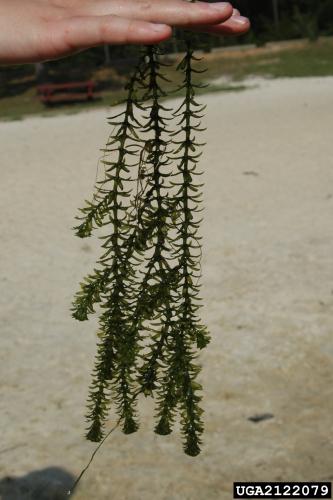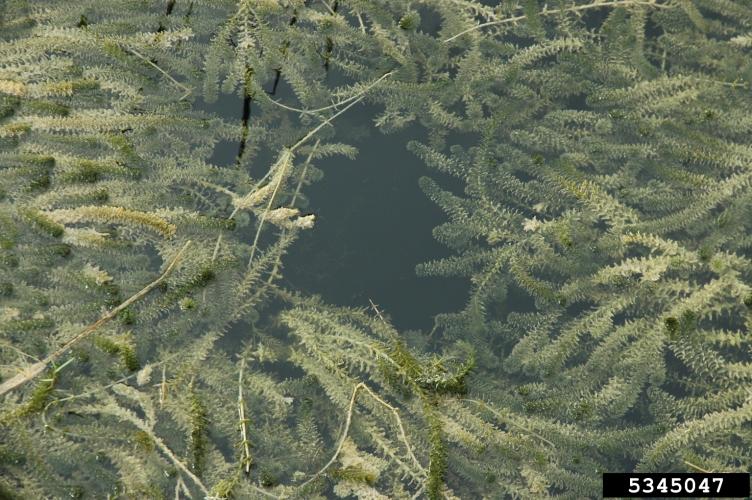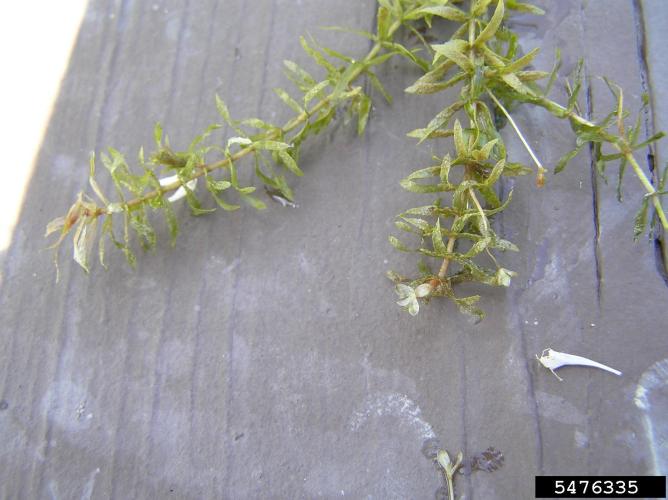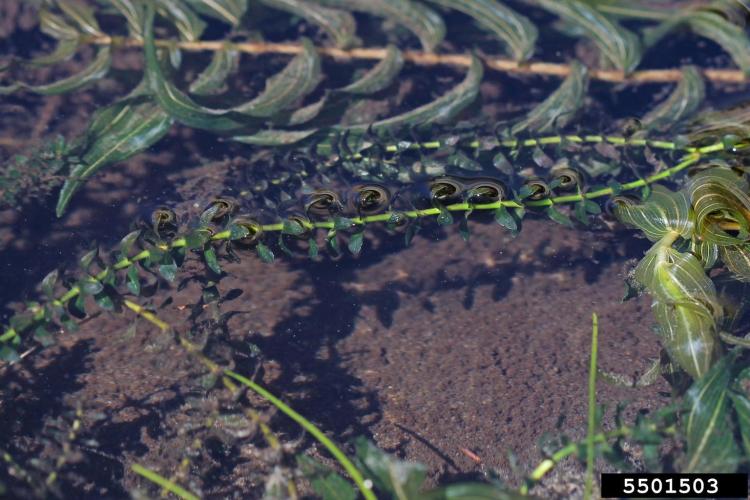Hydrilla
Identification
Appearance
Hydrilla roots to the substrate under a water body and grows vertically toward the water’s surface. It can grow up to 7m underwater, producing a stiff stem. Leaves grow directly off of the stem in a whorled formation, resulting in a thin, leafy plant. Reaching the surface, hydrilla begins growing horizontally, and can produce thick mats when many plants are growing together. Hydrilla produces small flowers that sit on the water’s surface.
Foliage
Hydrilla leaves are 10-15mm long and 2-4mm wide. They are visibly serrated and have a spined midrib on their bottom side. These two features help distinguish hydrilla from Brazilian elodea. Leaves grow directly off of the stem in whorls of 4-8 and are bright green.
Flowers
Hydrilla flowers are 3-petaled and white. The petals are 1-5cm long and 4-8mm wide. Yellow stamens and pisti ls are visible in the flower’s center. Flowers are attached to leaf axials and tend to be produced near the end of a stem. They sit on the surface of the water.
View lookalikes from New Hampshire Department of Environmental Services
Biology
Habitat
Hydrilla can grow in slow-moving or still freshwater bodies, as well as in slightly brackish water (<7 ppt salinity). It is tolerant of a wide variety of environmental conditions and competes well when conditions are limiting. Hydrilla can survive in low light, carbon, phosphorous and nitrogen conditions. It grows best between 20-27C but is hardy and can overwinter in freezing conditions through seeds and tubers.
Life Cycle
Hydrilla can reproduce both asexually and sexually, relying most heavily on asexual reproduction through tubers. Below ground, hydrilla grows small tubers to store nutrients. They rely on these tubers to overwinter, and to resprout in the Spring as temperatures warm. Hydrilla also produces turions (dormant buds) which detach from the plant in the fall. They spread downstream and lay dormant in the substrate until temperatures warm. The majority of hydrilla growth occurs in the late spring through early fall, when temperatures are between 20-27C. It grows rapidly, able to double its biomass several times throughout a growing season. It flowers in late summer and dies back as temperatures drop. When temperatures are freezing, hydrilla is reduced to overwintering in the form of tubers and turions in the substrate.
Ecological Threat
Hydrilla spreads rapidly and is able to outcompete native vegetation. It can grow in limited light and carbon conditions, allowing hydrilla to grow into dense mats that result in monocultures. In addition to impacting native plant populations, monocultures reduce habitat and food availability for animal species, leading to overall reduced biodiversity. Hydrilla monocultures also alter water chemistry and reduce oxygen levels, further endangering animal populations. Additionally, thick hydrilla mats have been known to clog mechanical equipment and hinder recreational activities.
Vermont Distribution
Hydrilla has not been reported in Vermont.
How You Can Help
For most aquatic invasive species, humans are the primary vector of transport from one waterbody to another. Many of these nuisance plants and animals can be unknowingly carried on fishing gear, boating equipment, or in very small amounts of water in a watercraft. The easiest and most effective means to ensure that you are not moving aquatic invasive species is to make sure that your vessel, as well as all your gear, is drained, clean, and dry.
CLEAN off any mud, plants, and animals from boat, trailer, motor and other equipment. Discard removed material in a trash receptacle or on high, dry ground where there is no danger of them washing into any water body.
DRAIN all water from boat, boat engine, and other equipment away from the water.
DRY anything that comes into contact with the water. Drying boat, trailer, and equipment in the sun for at least five days is recommended. If this is not possible, then rinse your boat, trailer parts, and other equipment with hot, high-pressure water.
Citations
Photo Credit
5345047: David J. Moorhead, University of Georgia, Bugwood.org
2122079: Chris Evans, University of Illinois, Bugwood.org
5476335: Cleveland Metroparks, Bugwood.org
Information Credit
Bachman, Sharon. “Ecological Impacts of Hydrilla.” Cornell Cooperative Extension, 21 Apr. 2025, erie.cce.cornell.edu/invasive-species/ecological-impacts-of-hydrilla.
“Hydrilla.” Sea Grant Pennsylvania, PSU, 12 Dec. 2024, seagrant.psu.edu/resources/resource-item/hydrilla/.
Laboratory, NOAA Great Lakes Environmental Research1. “NOAA National Center for Research on Aquatic Invasive Species (NCRAIS).” Nas.er.usgs.gov, 5 Jan. 2020, nas.er.usgs.gov/queries/greatlakes/FactSheet.aspx?Species_ID=6&Potential=Y&Type=2&HUCNumber.
Vermont Invasive Exotic Plant Fact Sheet. Vermont Department of Environmental Conservation, 1998.



